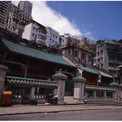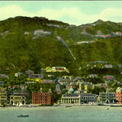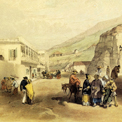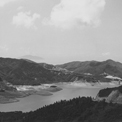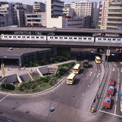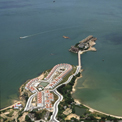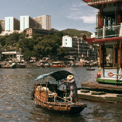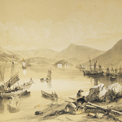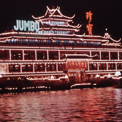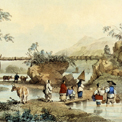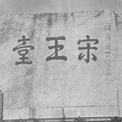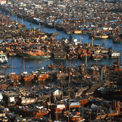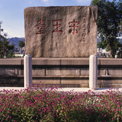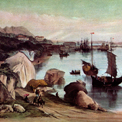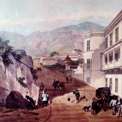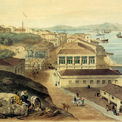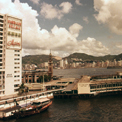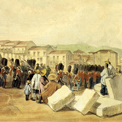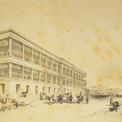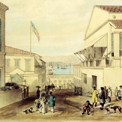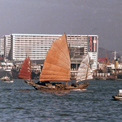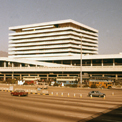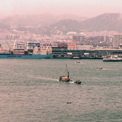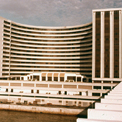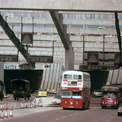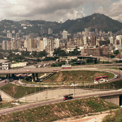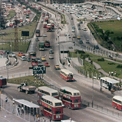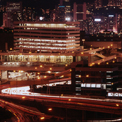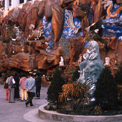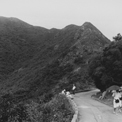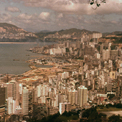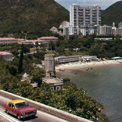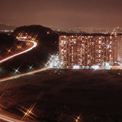Sung Wong Toi Rock, Kowloon City
The boulder once stood prominently on the top of a hill above Kowloon Bay. During the Japanese Occupation of Hong Kong in 1942-1945, this boulder became dislodged while the hill was being levelled for an extension to Kai Tak Airport. The part of the boulder displaying the three characters, about one-third of its original size, survived the blasting operations and after the war it was rescued and placed in a small park especially constructed for it close to the original site. The inscription has been interpreted as "Terrace of the Sung King", by local tradition connected with the temporary sojourn in the area of the two boy-emperors.
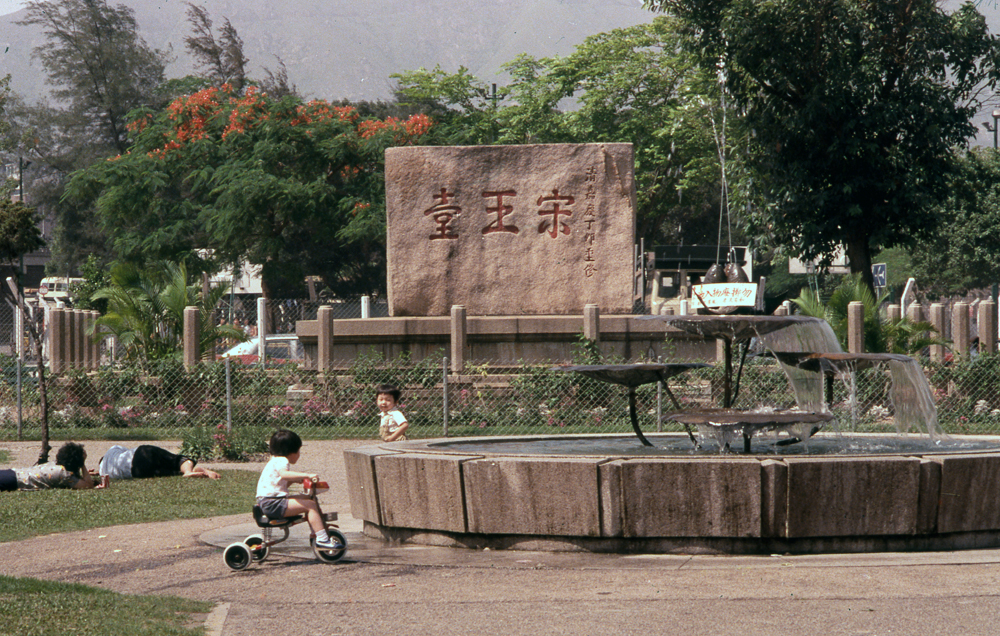
| Date | c.1980s |
| Place | Kowloon/Kowloon City District/Kowloon City/(Street)/Sung Wong Toi Rock |
| Material Type | Image |
| Collection | Hong Kong Places |
| Source | Courtesy of The University of Hong Kong Libraries |
| Repository | The University of Hong Kong Libraries |
| Accession No. | S2008.0151 |
Sung Wong Toi Rock, Kowloon City
The boulder once stood prominently on the top of a hill above Kowloon Bay. During the Japanese Occupation of Hong Kong in 1942-1945, this boulder became dislodged while the hill was being levelled for an extension to Kai Tak Airport. The part of the boulder displaying the three characters, about one-third of its original size, survived the blasting operations and after the war it was rescued and placed in a small park especially constructed for it close to the original site. The inscription has been interpreted as "Terrace of the Sung King", by local tradition connected with the temporary sojourn in the area of the two boy-emperors.
| Date | c.1980s |
| Place | Kowloon/Kowloon City District/Kowloon City/(Street)/Sung Wong Toi Rock |
| Material Type | Image |
| Collection | Hong Kong Places |
| Source | Courtesy of The University of Hong Kong Libraries |
| Repository | The University of Hong Kong Libraries |
| Accession No. | S2008.0151 |
Sung Wong Toi Rock, Kowloon City
The boulder once stood prominently on the top of a hill above Kowloon Bay. During the Japanese Occupation of Hong Kong in 1942-1945, this boulder became dislodged while the hill was being levelled for an extension to Kai Tak Airport. The part of the boulder displaying the three characters, about one-third of its original size, survived the blasting operations and after the war it was rescued and placed in a small park especially constructed for it close to the original site. The inscription has been interpreted as "Terrace of the Sung King", by local tradition connected with the temporary sojourn in the area of the two boy-emperors.
| Date | c.1980s |
| Place | Kowloon/Kowloon City District/Kowloon City/(Street)/Sung Wong Toi Rock |
| Material Type | Image |
| Collection | Hong Kong Places |
| Source | Courtesy of The University of Hong Kong Libraries |
| Repository | The University of Hong Kong Libraries |
| Accession No. | S2008.0151 |
Sung Wong Toi Rock, Kowloon City
The boulder once stood prominently on the top of a hill above Kowloon Bay. During the Japanese Occupation of Hong Kong in 1942-1945, this boulder became dislodged while the hill was being levelled for an extension to Kai Tak Airport. The part of the boulder displaying the three characters, about one-third of its original size, survived the blasting operations and after the war it was rescued and placed in a small park especially constructed for it close to the original site. The inscription has been interpreted as "Terrace of the Sung King", by local tradition connected with the temporary sojourn in the area of the two boy-emperors.
| Date | c.1980s |
| Place | Kowloon/Kowloon City District/Kowloon City/(Street)/Sung Wong Toi Rock |
| Material Type | Image |
| Collection | Hong Kong Places |
| Source | Courtesy of The University of Hong Kong Libraries |
| Repository | The University of Hong Kong Libraries |
| Accession No. | S2008.0151 |
Sung Wong Toi Rock, Kowloon City
The boulder once stood prominently on the top of a hill above Kowloon Bay. During the Japanese Occupation of Hong Kong in 1942-1945, this boulder became dislodged while the hill was being levelled for an extension to Kai Tak Airport. The part of the boulder displaying the three characters, about one-third of its original size, survived the blasting operations and after the war it was rescued and placed in a small park especially constructed for it close to the original site. The inscription has been interpreted as "Terrace of the Sung King", by local tradition connected with the temporary sojourn in the area of the two boy-emperors.
| Date | c.1980s |
| Material Type | Image |
| Collection | Hong Kong Places |
| Source | Courtesy of The University of Hong Kong Libraries |
| Repository | The University of Hong Kong Libraries |
| Accession No. | S2008.0151 |
Sung Wong Toi Rock, Kowloon City
The boulder once stood prominently on the top of a hill above Kowloon Bay. During the Japanese Occupation of Hong Kong in 1942-1945, this boulder became dislodged while the hill was being levelled for an extension to Kai Tak Airport. The part of the boulder displaying the three characters, about one-third of its original size, survived the blasting operations and after the war it was rescued and placed in a small park especially constructed for it close to the original site. The inscription has been interpreted as "Terrace of the Sung King", by local tradition connected with the temporary sojourn in the area of the two boy-emperors.
| Date | c.1980s |
| Place | Kowloon/Kowloon City District/Kowloon City/(Street)/Sung Wong Toi Rock |
| Material Type | Image |
| Collection | Hong Kong Places |
| Source | Courtesy of The University of Hong Kong Libraries |
| Repository | The University of Hong Kong Libraries |
| Accession No. | S2008.0151 |
Sung Wong Toi Rock, Kowloon City
The boulder once stood prominently on the top of a hill above Kowloon Bay. During the Japanese Occupation of Hong Kong in 1942-1945, this boulder became dislodged while the hill was being levelled for an extension to Kai Tak Airport. The part of the boulder displaying the three characters, about one-third of its original size, survived the blasting operations and after the war it was rescued and placed in a small park especially constructed for it close to the original site. The inscription has been interpreted as "Terrace of the Sung King", by local tradition connected with the temporary sojourn in the area of the two boy-emperors.
| Date | c.1980s |
| Place | Kowloon/Kowloon City District/Kowloon City/(Street)/Sung Wong Toi Rock |
| Material Type | Image |
| Collection | Hong Kong Places |
| Source | Courtesy of The University of Hong Kong Libraries |
| Repository | The University of Hong Kong Libraries |
| Accession No. | S2008.0151 |
Sung Wong Toi Rock, Kowloon City
The boulder once stood prominently on the top of a hill above Kowloon Bay. During the Japanese Occupation of Hong Kong in 1942-1945, this boulder became dislodged while the hill was being levelled for an extension to Kai Tak Airport. The part of the boulder displaying the three characters, about one-third of its original size, survived the blasting operations and after the war it was rescued and placed in a small park especially constructed for it close to the original site. The inscription has been interpreted as "Terrace of the Sung King", by local tradition connected with the temporary sojourn in the area of the two boy-emperors.
| Date of Death | c.1980s |
| Place | Kowloon/Kowloon City District/Kowloon City/(Street)/Sung Wong Toi Rock |
| Material Type | Image |
| Collection | Hong Kong Places |
| Source | Courtesy of The University of Hong Kong Libraries |
| Repository | The University of Hong Kong Libraries |
| Accession No. | S2008.0151 |
Sung Wong Toi Rock, Kowloon City
The boulder once stood prominently on the top of a hill above Kowloon Bay. During the Japanese Occupation of Hong Kong in 1942-1945, this boulder became dislodged while the hill was being levelled for an extension to Kai Tak Airport. The part of the boulder displaying the three characters, about one-third of its original size, survived the blasting operations and after the war it was rescued and placed in a small park especially constructed for it close to the original site. The inscription has been interpreted as "Terrace of the Sung King", by local tradition connected with the temporary sojourn in the area of the two boy-emperors.
| Date | c.1980s |
| Material Type | Image |
| Collection | Hong Kong Places |
| Source | Courtesy of The University of Hong Kong Libraries |
| Accession No. | S2008.0151 |
Sung Wong Toi Rock, Kowloon City
The boulder once stood prominently on the top of a hill above Kowloon Bay. During the Japanese Occupation of Hong Kong in 1942-1945, this boulder became dislodged while the hill was being levelled for an extension to Kai Tak Airport. The part of the boulder displaying the three characters, about one-third of its original size, survived the blasting operations and after the war it was rescued and placed in a small park especially constructed for it close to the original site. The inscription has been interpreted as "Terrace of the Sung King", by local tradition connected with the temporary sojourn in the area of the two boy-emperors.
| Date | c.1980s |
| Material Type | Image |
| Place | Kowloon/Kowloon City District/Kowloon City/(Street)/Sung Wong Toi Rock |
| Collection | Hong Kong Places |
| Source | Courtesy of The University of Hong Kong Libraries |
| Repository | The University of Hong Kong Libraries |
| Accession No. | S2008.0151 |
Sung Wong Toi Rock, Kowloon City
The boulder once stood prominently on the top of a hill above Kowloon Bay. During the Japanese Occupation of Hong Kong in 1942-1945, this boulder became dislodged while the hill was being levelled for an extension to Kai Tak Airport. The part of the boulder displaying the three characters, about one-third of its original size, survived the blasting operations and after the war it was rescued and placed in a small park especially constructed for it close to the original site. The inscription has been interpreted as "Terrace of the Sung King", by local tradition connected with the temporary sojourn in the area of the two boy-emperors.
| Date | c.1980s |
| Place | Kowloon/Kowloon City District/Kowloon City/(Street)/Sung Wong Toi Rock |
| Material Type | Image |
| Collection | Hong Kong Places |
| Source | Courtesy of The University of Hong Kong Libraries |
| Repository | The University of Hong Kong Libraries |
| Accession No. | S2008.0151 |
Sung Wong Toi Rock, Kowloon City
The boulder once stood prominently on the top of a hill above Kowloon Bay. During the Japanese Occupation of Hong Kong in 1942-1945, this boulder became dislodged while the hill was being levelled for an extension to Kai Tak Airport. The part of the boulder displaying the three characters, about one-third of its original size, survived the blasting operations and after the war it was rescued and placed in a small park especially constructed for it close to the original site. The inscription has been interpreted as "Terrace of the Sung King", by local tradition connected with the temporary sojourn in the area of the two boy-emperors.
| Date | c.1980s |
| Place | Kowloon/Kowloon City District/Kowloon City/(Street)/Sung Wong Toi Rock |
| Material Type | Image |
| Collection | Hong Kong Places |
| Source | Courtesy of The University of Hong Kong Libraries |
| Repository | The University of Hong Kong Libraries |
| Accession No. | S2008.0151 |
Sung Wong Toi Rock, Kowloon City
The boulder once stood prominently on the top of a hill above Kowloon Bay. During the Japanese Occupation of Hong Kong in 1942-1945, this boulder became dislodged while the hill was being levelled for an extension to Kai Tak Airport. The part of the boulder displaying the three characters, about one-third of its original size, survived the blasting operations and after the war it was rescued and placed in a small park especially constructed for it close to the original site. The inscription has been interpreted as "Terrace of the Sung King", by local tradition connected with the temporary sojourn in the area of the two boy-emperors.
| Date | c.1980s |
| Place | Kowloon/Kowloon City District/Kowloon City/(Street)/Sung Wong Toi Rock |
| Material Type | Image |
| Collection | Hong Kong Places |
| Source | Courtesy of The University of Hong Kong Libraries |
| Repository | The University of Hong Kong Libraries |
| Accession No. | S2008.0151 |
Sung Wong Toi Rock, Kowloon City
The boulder once stood prominently on the top of a hill above Kowloon Bay. During the Japanese Occupation of Hong Kong in 1942-1945, this boulder became dislodged while the hill was being levelled for an extension to Kai Tak Airport. The part of the boulder displaying the three characters, about one-third of its original size, survived the blasting operations and after the war it was rescued and placed in a small park especially constructed for it close to the original site. The inscription has been interpreted as "Terrace of the Sung King", by local tradition connected with the temporary sojourn in the area of the two boy-emperors.
| Date | c.1980s |
| Place | Kowloon/Kowloon City District/Kowloon City/(Street)/Sung Wong Toi Rock |
| Material Type | Image |
| Collection | Hong Kong Places |
| Source | Courtesy of The University of Hong Kong Libraries |
| Repository | The University of Hong Kong Libraries |
| Accession No. | S2008.0151 |
Sung Wong Toi Rock, Kowloon City
The boulder once stood prominently on the top of a hill above Kowloon Bay. During the Japanese Occupation of Hong Kong in 1942-1945, this boulder became dislodged while the hill was being levelled for an extension to Kai Tak Airport. The part of the boulder displaying the three characters, about one-third of its original size, survived the blasting operations and after the war it was rescued and placed in a small park especially constructed for it close to the original site. The inscription has been interpreted as "Terrace of the Sung King", by local tradition connected with the temporary sojourn in the area of the two boy-emperors.
| Date | c.1980s |
| Place | Kowloon/Kowloon City District/Kowloon City/(Street)/Sung Wong Toi Rock |
| Material Type | Image |
| Collection | Hong Kong Places |
| Source | Courtesy of The University of Hong Kong Libraries |
| Repository | The University of Hong Kong Libraries |
| Accession No. | S2008.0151 |
Sung Wong Toi Rock, Kowloon City
The boulder once stood prominently on the top of a hill above Kowloon Bay. During the Japanese Occupation of Hong Kong in 1942-1945, this boulder became dislodged while the hill was being levelled for an extension to Kai Tak Airport. The part of the boulder displaying the three characters, about one-third of its original size, survived the blasting operations and after the war it was rescued and placed in a small park especially constructed for it close to the original site. The inscription has been interpreted as "Terrace of the Sung King", by local tradition connected with the temporary sojourn in the area of the two boy-emperors.
| Date | c.1980s |
| Place | Kowloon/Kowloon City District/Kowloon City/(Street)/Sung Wong Toi Rock |
| Material Type | Image |
| Collection | Hong Kong Places |
| Source | Courtesy of The University of Hong Kong Libraries |
| Repository | The University of Hong Kong Libraries |
| Accession No. | S2008.0151 |
Sung Wong Toi Rock, Kowloon City
The boulder once stood prominently on the top of a hill above Kowloon Bay. During the Japanese Occupation of Hong Kong in 1942-1945, this boulder became dislodged while the hill was being levelled for an extension to Kai Tak Airport. The part of the boulder displaying the three characters, about one-third of its original size, survived the blasting operations and after the war it was rescued and placed in a small park especially constructed for it close to the original site. The inscription has been interpreted as "Terrace of the Sung King", by local tradition connected with the temporary sojourn in the area of the two boy-emperors.
| Date | c.1980s |
| Place | Kowloon/Kowloon City District/Kowloon City/(Street)/Sung Wong Toi Rock |
| Material Type | Image |
| Collection | Hong Kong Places |
| Source | Courtesy of The University of Hong Kong Libraries |
| Repository | The University of Hong Kong Libraries |
| Accession No. | S2008.0151 |
Sung Wong Toi Rock, Kowloon City
The boulder once stood prominently on the top of a hill above Kowloon Bay. During the Japanese Occupation of Hong Kong in 1942-1945, this boulder became dislodged while the hill was being levelled for an extension to Kai Tak Airport. The part of the boulder displaying the three characters, about one-third of its original size, survived the blasting operations and after the war it was rescued and placed in a small park especially constructed for it close to the original site. The inscription has been interpreted as "Terrace of the Sung King", by local tradition connected with the temporary sojourn in the area of the two boy-emperors.
| Date | c.1980s |
| Place | Kowloon/Kowloon City District/Kowloon City/(Street)/Sung Wong Toi Rock |
| Material Type | Image |
| Collection | Hong Kong Places |
| Source | Courtesy of The University of Hong Kong Libraries |
| Repository | The University of Hong Kong Libraries |
| Accession No. | S2008.0151 |
Copyright © 2012 Hong Kong Memory



